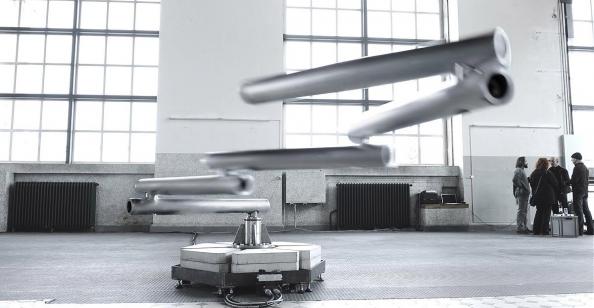
The project Cycloïd-E is a spectacular sound sculpture – a 10-meter diameter pendulum, which astonishes not only with its size, but also with the fluidity of movement, sound, refinement and elegance. Metal tubes equipped with instruments resonate depending on the rotation. Cycloïd-E creates a kinetic and polyphonic whole, drawing on a broader reflection on the “harmony of the spheres”. The artists refer to the example of Pythagoras, who maintained that the world had been created from chaos by sound and harmony, thus in accordance with the rules of musical proportions. The distances between the planets were to correspond to music intervals. According to Pythagoras, planets were in harmonic motions and generated music that was inaudible to us due to the sublimity of its sounds and maladjustment of our ears. Almost 1000 years later, in 1619, an astronomer Johannes Kepler in his The Harmony of the World attempted to explain the proportions of the world in music terms. Drawing on Pythagoras’ music of the spheres, he claimed that every planet emits a sound whose pitch is dependent on the velocity with which it orbits. Both in Pythagoras’ and Kepler’s descriptions, the structure of the universe is akin to the structure of a music piece. The two examples show that reflection on the relationship between movement and sound, of interest to the brothers Décosterd, was once part of wider deliberation on the harmony of the world.
Brothers, ANDRÉ and MICHEL DÉCOSTERD, or Cod.Act, work at the meeting point of art and science. André Décosterd is a musician and composer. He received a degree from the School of Jazz and Contemporary Music (EJMA) in Lausanne and specializes in programming computer music applications. His interests lie in contemporary composition systems, in particular algorithmic composition. Michel Décosterd is an architect. He received a degree in architecture from University of Technology in Bienne. In the years 1994-1996 he worked as an architect in Berlin and Weimar. In 1997 the brothers formed COD.ACT within which they create installations and performances in the form of harmonious movement and sound compositions, inspired by the observation of physical and chemical phenomena as well as the reflection on the possible interactions between sound and movement, machine and human being.